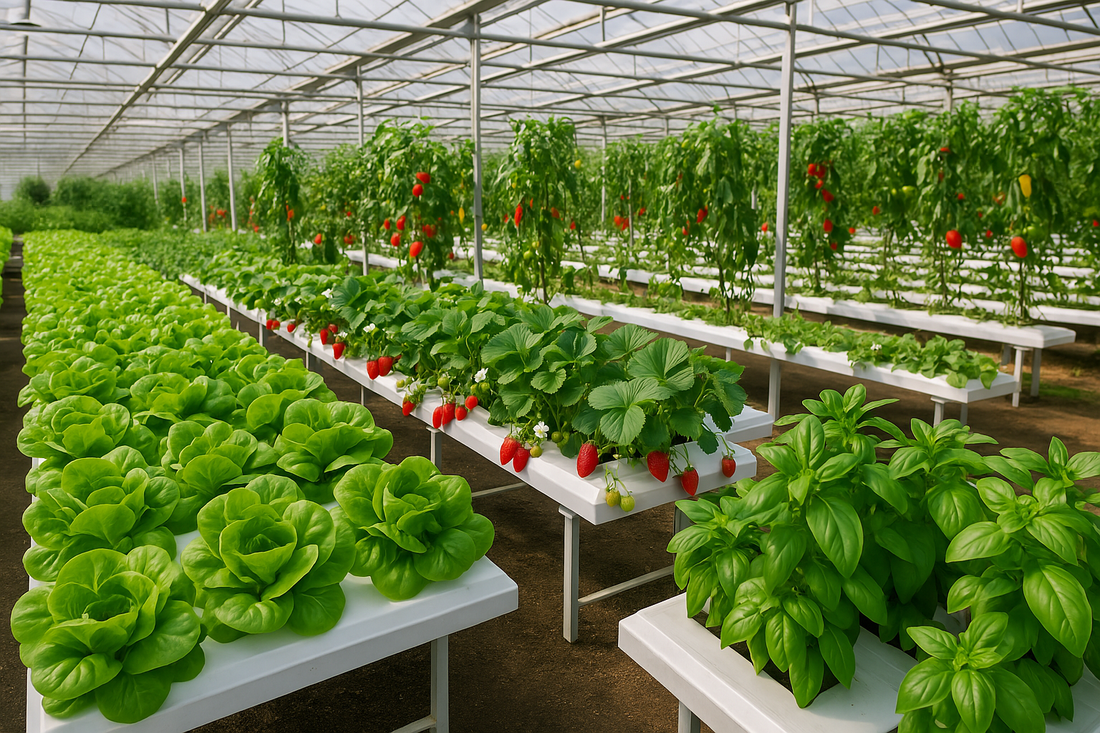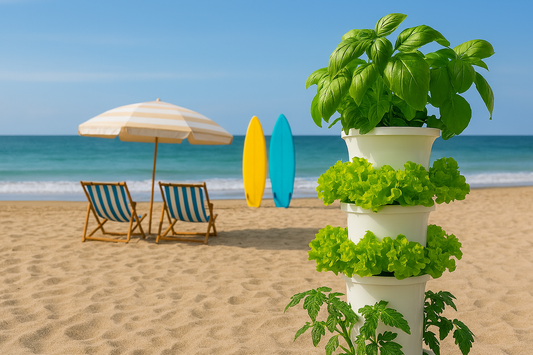
Crop Selection for Hydroponic Systems
Hydroponics offers a unique and adaptable way to grow nearly any plant. Its versatility stems from the ability to fine-tune environmental conditions—often creating a growing space even more ideal than nature itself. But while we can replicate much of nature’s balance, there are some relationships it still resists. Some plants simply don’t grow well near others.
That’s why plant compatibility is critical in hydroponic systems. Certain crops share similar EC, pH, temperature, and lighting needs and can thrive together. Others differ so much they require their own dedicated systems to avoid stunted growth or nutrient imbalance.
This guide will walk you through the potential pitfalls of mixing incompatible plants in the same hydroponic system—and help you make smart decisions when space or resources make single-crop systems impractical.
Plant Compatibility & Nutrient Needs
Leafy greens thrive under lower EC levels (0.8–2.2 mS/cm), while fruiting crops such as tomatoes typically require higher EC (2.5–3.5 mS/cm). Combining crops with such different nutrient demands in the same system can result in issues like nutrient stress, tip burn, or inhibited growth if not carefully managed.
Throughout this guide, we use the term "incompatible" to describe crop pairings that are more difficult to grow together—not impossible. With diligent monitoring, tailored adjustments, and proper acclimation, many of these pairings can still succeed. Think of it less as a restriction and more as a cue for closer observation and planning.
| Plant Name | EC Range (mS/cm) | pH Range | Water Temp (°C) | PPFD (µmol/m²/s) | Not Recommended With |
|---|---|---|---|---|---|
| Lettuce | 0.8–2.2 | 5.8–6.5Aim for an average of ~6.0 over time. Outliers are okay—consistency matters most. | 18–22Approx. 64–72°F | 150–250 | High-EC crops (Tomatoes, Peppers) |
| Spinach | 1.8–2.3 | 6.0–6.5Aim for an average of ~6.0 over time. | 18–24Approx. 64–75°F | 200–300 | Fruiting plants (Eggplant, Strawberries) |
| Tomatoes | 2.5–3.5 | 5.5–6.5Aim for an average of ~6.0 over time. | 20–26Approx. 68–78°F | 400–600 | Low-EC greens (Lettuce) |
| Strawberries | 1.2–1.8 | 5.5–6.5Aim for an average of ~6.0 over time. | 18–24Approx. 64–75°F | 300–400 | High-EC plants (Peppers) |
| Peppers | 2.0–3.0 | 5.5–6.5Aim for an average of ~6.0 over time. | 22–26Approx. 72–78°F | 500–700 | Low-EC leafy greens (Lettuce) |
| Basil | 1.0–1.6 | 5.5–6.5Aim for an average of ~6.0 over time. | 18–25Approx. 64–77°F | 250–400 | pH-sensitive plants (Strawberries) |
| Eggplant | 2.5–3.5 | 5.5–6.5Aim for an average of ~6.0 over time. | 22–28Approx. 72–82°F | 500–800 | Low-EC greens (Lettuce) |
| Radish | 1.6–2.2 | 6.0–6.8Aim for an average of ~6.0 over time. | 18–22Approx. 64–72°F | 250–400 | Fruiting plants (Tomatoes, Peppers) |
| Kale | 1.2–2.0 | 5.5–6.5Aim for an average of ~6.0 over time. | 18–24Approx. 64–75°F | 250–400 | High-EC plants (Peppers, Tomatoes) |
| Cilantro | 1.2–1.8 | 6.0–6.5Aim for an average of ~6.0 over time. | 18–22Approx. 64–72°F | 200–350 | Heat-sensitive plants (Peppers) |
| Cucumbers | 1.8–2.5 | 5.5–6.5Aim for an average of ~6.0 over time. | 22–28Approx. 72–82°F | 400–600 | Root crops (Carrots, Radish) |
| Chives | 1.2–1.6 | 6.0–6.5Aim for an average of ~6.0 over time. | 18–22Approx. 64–72°F | 200–350 | Heat-sensitive plants (Peppers) |
| Scallions (Green Onions) | 1.4–2.0 | 6.0–6.8Aim for an average of ~6.0 over time. | 18–22Approx. 64–72°F | 250–400 | Root crops (Carrots, Radish) |
| Sugar Baby Melons | 2.5–3.5 | 5.8–6.5Aim for an average of ~6.0 over time. | 22–28Approx. 72–82°F | 500–700 | Cool-weather greens (Lettuce, Spinach) |
| Celery | 1.8–2.4 | 6.0–6.5Aim for an average of ~6.0 over time. | 18–22Approx. 64–72°F | 200–400 | High-EC plants (Tomatoes, Peppers) |
| Arugula | 1.0–2.0 | 6.0–7.0Aim for an average of ~6.0 over time. | 18–22Approx. 64–72°F | 200–300 | Slow-growing crops (Cauliflower, Cabbage) |
| Collard Greens | 2.0–2.6 | 6.0–6.5Aim for an average of ~6.0 over time. | 18–24Approx. 64–75°F | 250–400 | Low-EC greens (Lettuce, Basil) |
| Cauliflower | 2.0–3.0 | 6.0–7.0Aim for an average of ~6.0 over time. | 18–24Approx. 64–75°F | 300–450 | Short-cycle leafy greens (Spinach, Arugula) |
| Cabbage | 2.5–3.0 | 6.0–6.5Aim for an average of ~6.0 over time. | 18–24Approx. 64–75°F | 300–500 | Low-EC crops (Lettuce, Strawberries) |
| Kohlrabi | 1.8–2.5 | 6.0–6.8Aim for an average of ~6.2. Brassicas tolerate slight pH drift. | 18–24Approx. 64–75°F | 250–400 | Strawberries, Fruiting plants (Tomatoes, Peppers) |
| Watercress | 1.5–2.0 | 6.0–6.5Keep pH stable—watercress is sensitive to swings. | 16–22Approx. 61–72°F | 200–350 | High-temp crops (Peppers, Eggplant) |
Managing Incompatible Plants in Shared Systems
Despite their incompatibilities, some plants can be grown together with careful adjustments.:
- Acclimating leafy greens like lettuce to higher EC levels (e.g., 1.8–2.2 mS/cm) can lead to burnt edges and slow growth, but gradual adaptation may reduce stress.
- Strawberries grown alongside tomatoes must have precise pH monitoring to prevent nutrient lockout due to higher acidity demands.
- Using separate nutrient reservoirs or drip feed systems can help isolate variable nutrient uptake and minimize adverse effects.
Optimizing Growth with Strategic Nutrient Management
In hydroponic systems, precise nutrient control ensures healthy plant development. Using targeted solutions like:
- Veg+Bloom for robust growth across fruiting crops.
- VBX for young seedlings or sensitive greens.
- PHLO for balanced macronutrient delivery.
- Shine for enhanced flowering and fruit production.
For deeper guidance on water preparation, vapor pressure deficit (VPD) control, and optimal germination conditions, check out our guides:
By understanding plant compatibility and nutrient requirements, growers can optimize their hydroponic system and achieve higher yields while minimizing stress factors.


